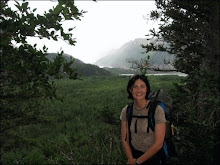
General
For a more in depth look at Adelie biology, check out the penguin science website at www.penguinscience.com. I've included a quick summary of what we know of these birds. The Adélie Penguin is a medium sized penguin (~28in tall, weighing 8-12lbs). It is a carnivorous bird, eating krill, fish, and squid. The Adélie penguin depends on large areas of pack ice because its main prey item, the Chrystal Krill, breeds under the ice. The penguins also rest and avoid predators on top of the ice. They spend their winter months (February-October) foraging far out to sea and they come to ice free land to breed in the summer months (Late October-February). Because of the rarity of ice-free, coastal areas, Adelies nest in dense colonies of up to several hundred thousand pairs. I will be studying Adélie Penguins during their breeding phase.

Breeding Biology
In the spring (late October in the southern hemisphere) the males migrate to the Antarctic continent or Antarctic islands to rebuild their nests and await the return of the females. The male constructs a mound of pebbles with a bowl in the center for eggs. Males will energetically guard their nests from other males looking for a nest site. Space is limited! The females return a few days later and choose their mates. They prefer to nest in the same location as the previous year, and in this way a female often pairs with the same male for consecutive years. About a week later, the female lays two eggs and then departs from the colony to forage for one or two weeks. She may have to walk several miles across ice to get to open water. Meanwhile, the male will incubate the eggs. Then she will return to incubate and the male will go to sea to forage. They will take turns in this way until the chicks hatch.

Chick rearing is much more demanding than egg care. Chicks grow fast and must eat frequently to gain the weight they need to leave the colony before winter. The adults will take turns foraging for food and brooding the chicks. When the chicks are small, they must be kept warm and guarded from predatory Skuas at all times. The Antarctic Skua is a large seabird which nests nearby. At three weeks, the chicks are large enough to keep themselves warm and they are too large for a Skua to drag away. They now need so much food that both parents must forage. The chicks huddle together in large groups called crèches, waiting for the return of a parent with a delicious meal of regurgitated krill. In late February, the chicks leave the crèches and go out to sea. They require no more care from the adults. They will spend the next few years hunting and gaining experience. At the age of 3 or 4, they will come back to the colony of their birth to practice building nests and attracting mates. By age 5 they will most likely have enough experience to raise chicks of their own. Adélie penguins have been known to live as long as 20 years in the wild.
Conservation Concerns
Global Climate Change: Adélie Penguins require pack ice for their survival. Global warming, caused by human use of fossil fuels, is quickly melting the world's ice. Adélie penguin colonies are disappearing from the northern Antarctic Peninsula. Alternately, penguin populations are growing in the Ross Sea, a southern area of Antarctica. The Ross Sea has historically been covered by a massive ice shelf. As this ice shelf breaks apart, it creates pack ice habitat for Adélie Penguins. The Ross Sea is the last refuge for this and many other Antarctic species. If global warming continues, even the Ross Sea will lose its ice cover, eliminating any chance of survival for Antarctic penguins.

Overfishing: Adélie penguins have been shown to have a much greater chance of raising chicks to fledging if their diet contains a high percentage of fish. There is little regulation of fishing practices in the Southern Ocean and many fish stocks have been severely depleted since the 1960's. Researchers think penguin diets now contain a much lower percentage of fish. Although Adélie Penguins can cope with this to some extent, populations of Emperor Penguins, Gentoo Penguins, and Chinstrap Penguins are quickly shrinking.


